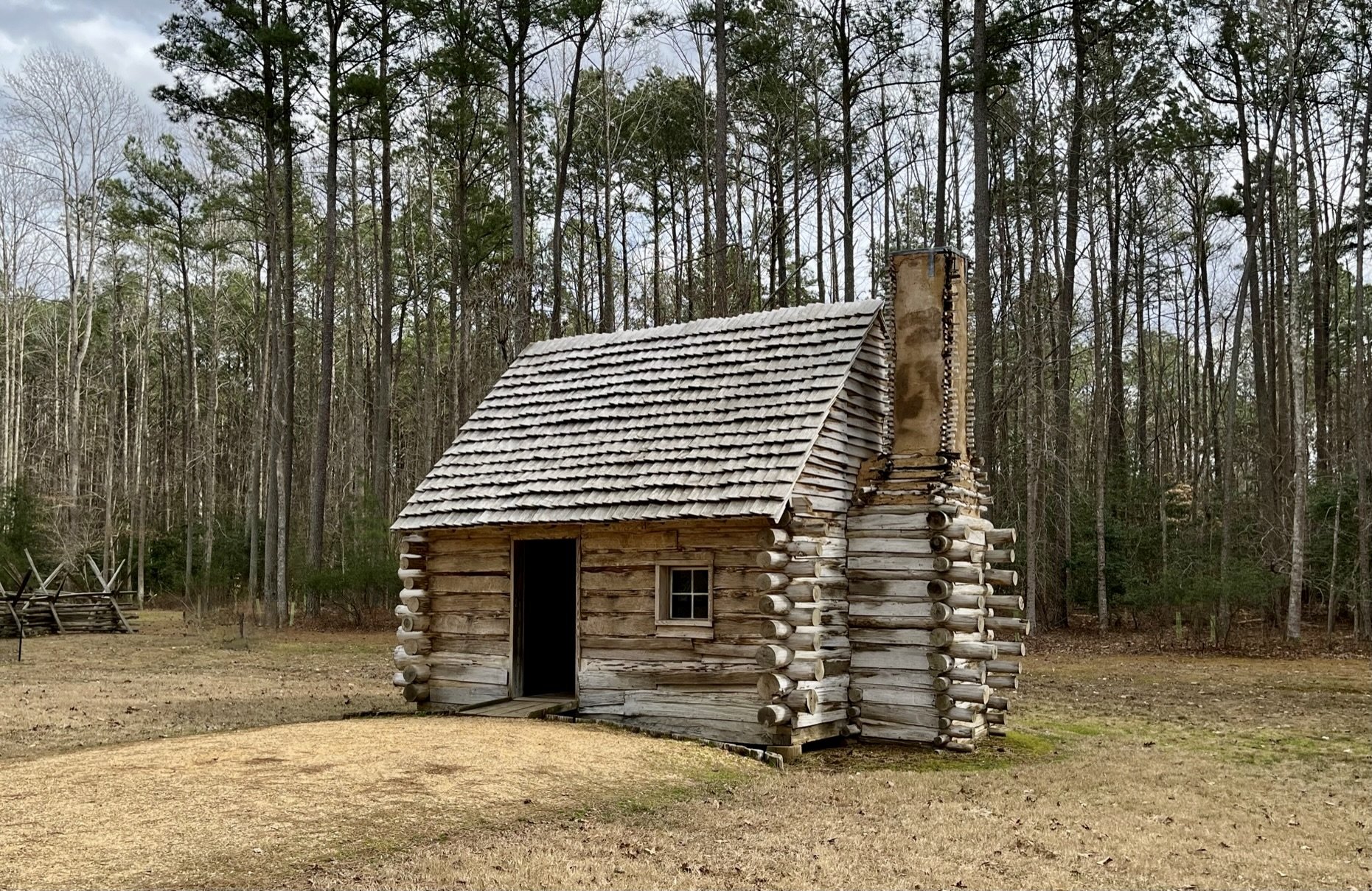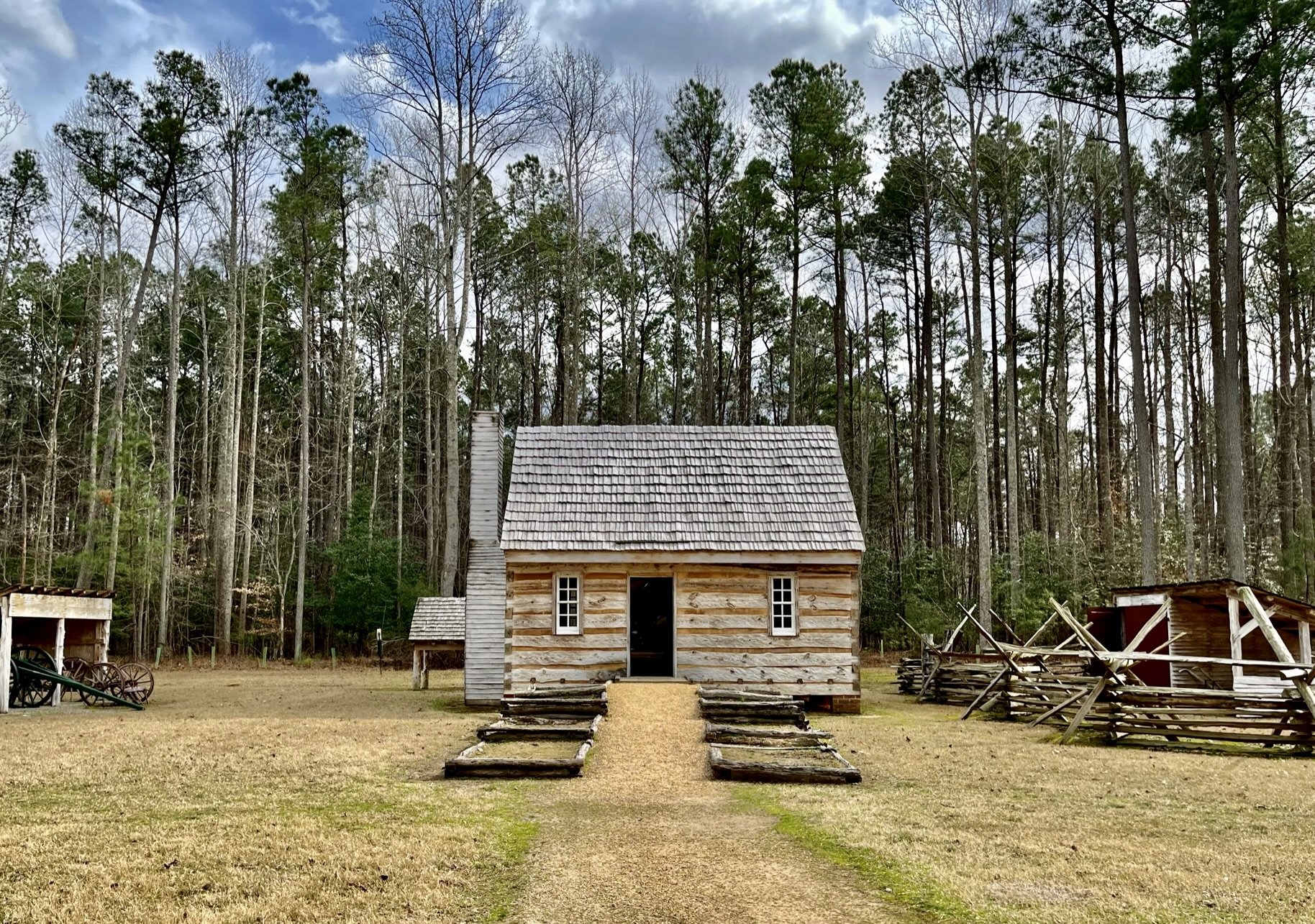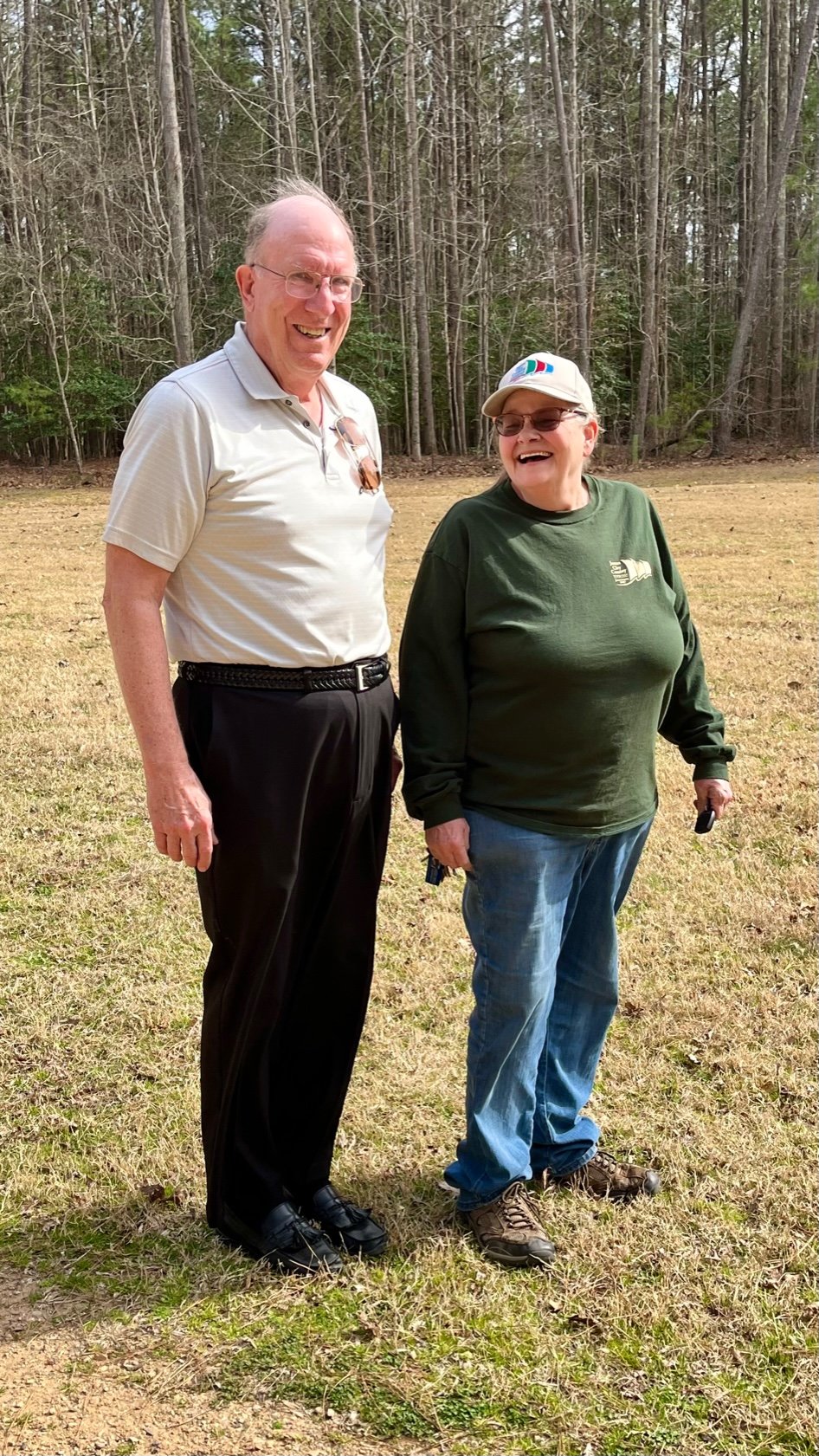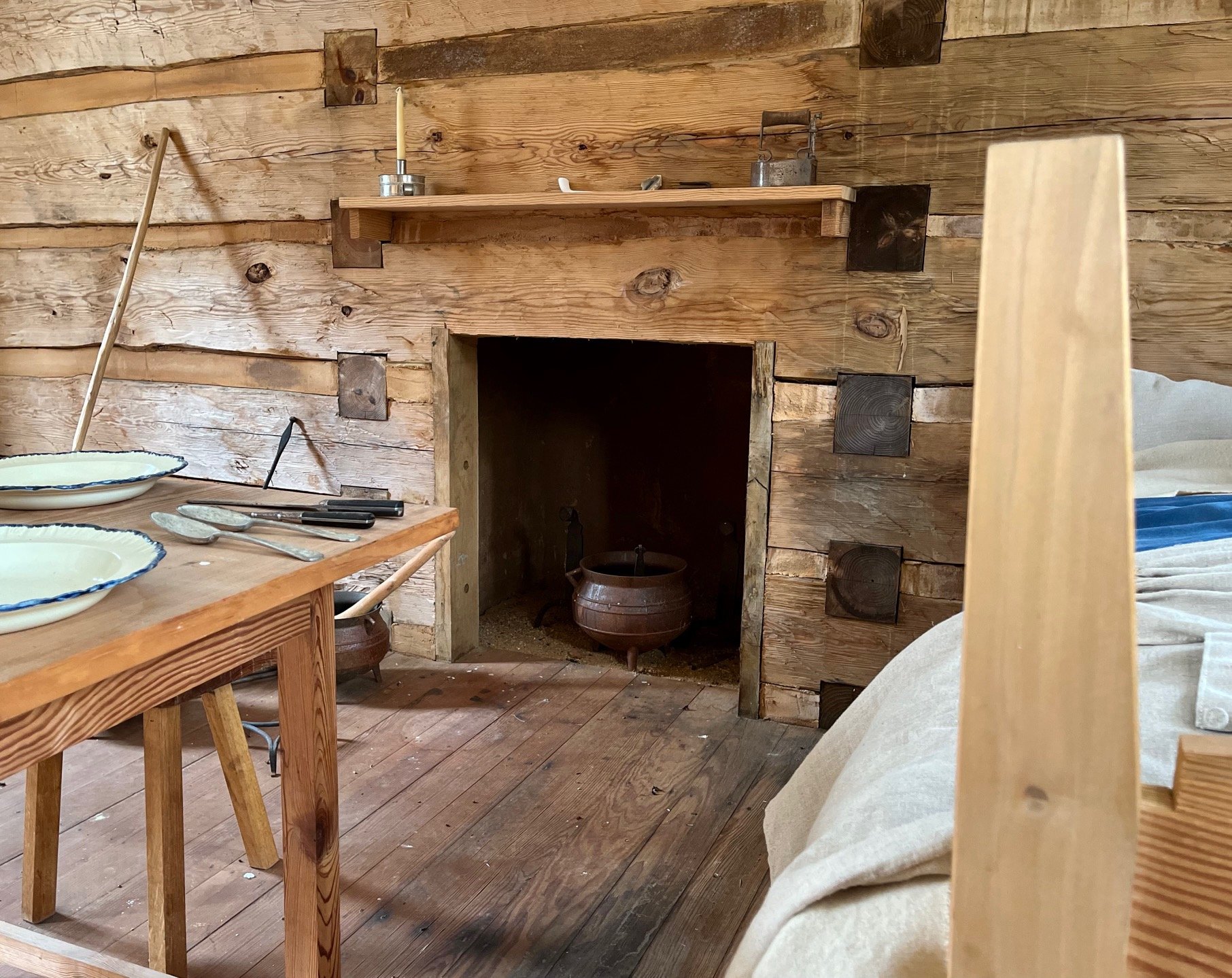John Jackson House
If you have built castles in the air, your work need not be lost; that is where they should be. Now put the foundations under them.
Henry David Thoreau, Walden
On Monday I visited Freedom Park to examine the cabins of a small community of Black freemen of post-revolutionary Williamsburg. The tour was arranged by my dear friend here locally, Dean Risseeuw, director of the Williamsburg chapter of the Service Corp of Retired Executives (SCORE), a national non-profit organization “dedicated to helping small businesses get off the ground.” We at Innermost House certainly qualify as small, if not quite as a business. And our struggle is not so much getting off the ground as it is getting settled on it. For five years we have built castles in the air. Now our challenge is to put foundations under them.
Powhatan, John Smith Map, 1612
The story of Freedom Park is a complicated one, like so much local history in this oldest of British settlements in North America. The land was settled at least 8,000 years ago by the ancient forebears of the American Indian peoples, following the retreat of the last Ice Age. The early inhabitants were hunter-gatherers who followed the seasons and the migratory patterns of game animals. As the region continued to warm, those inhabitants settled into towns along the tidal riverbanks, hunted, fished, and farmed, much as English settlers would do thousands of years after. They developed a complex culture of interdependence with the animals and plants, lands and waters they called Tsenacomoco, the “densely inhabited land” of the Tidewater region. They learned to live sustainably on the rich bounty of the Chesapeake Bay, its tidal rivers and estuaries.
By the early 17th century, American Indian peoples of the region that would become Virginia lived in three broad cultural groups based on language family: Algonquian, Iroquoian, and Siouan. We today know most about the Algonquian-speaking peoples of Tsenacomoco, who, by the time of the Jamestown landing, had formed into a paramount chiefdom under Powhatan. The confederacy consisted of about thirty small chiefdoms and tribes. These were the peoples first known to the early English settlers.
The first Africans arrived in the Tidewater region in 1619. They were confiscated from a Portuguese slave-trading ship bound from Angola to Mexico, bearing prisoners of the West African Kingdom of Ndongo seized in raids by other African peoples with whom the Ndongo were at war. The inter-African slave trade by that date was more than a thousand years old, and stretched still further back into remote antiquity. Britain was among last great European powers to enter into that long-preexisting slave trade, and slavery in British Virginia was not fully codified into law until 1705. One hundred years later, the historically unprecedented work of abolishing slavery world-wide had become a determined campaign of the British nation, with abolitionists on both sides of the Atlantic combining with growing Black resistance across the Empire and beyond. Its watchword and symbol was circulated in great numbers as a seal by the famed English potter, Josiah Wedgewood: “Am I Not a Man and a Brother?”
Into this storm of reform and revolution, thoughtful Virginians began to explore legal courses for manumission. The most famous case was probably George Washington, who freed those enslaved people in his possession in his will of 1799, to be enacted on his wife’s death. “Washington said he did not free them immediately because his slaves intermarried with his wife's dower slaves. He forbade their sale or transportation out of Virginia. His will provided that old and young freed people be taken care of indefinitely; younger ones were to be taught to read and write and placed in suitable occupations.”
Anthony Brown House
Four years later, the enslaved people living on the tract that is now Freedom Park were freed by a similar provision in the will of William Ludwell Lee, which directed that the nearly thirty newly free people in residence at the time of his death should be granted 1,200 acres for their exclusive use. The settlement thrived as a free Black community through the time of the Civil War. Between the Declaration of Independence in 1776 and the death of William Ludwell Lee in 1803, the number of Black freemen in Virginia increased tenfold, from 2,000 to over 20,000, largely in response to the principles of the Declaration. Those are the foundations of where and what we are today.
Dean Risseeuw and Terry Martin
Dean and I were conducted on our tour of the three cabins commemorating that community by James City County park guide Terry Martin. Terry was a splendid guide. As it proved, the cabins were not original structures, for the originals were mostly of that manner of building we have called “impermanent architecture.” Like our Virginia House Project, the cabins are reconstructions of early house-types, significant for the role they played in laying the foundations of the American experiment, but known to us today largely through archaeological and documentary evidence.
The buildings are well-made. Our master carpenter Garland Wood visited the park to see them last week, and admired their character and accuracy. They fairly represent between them three stages of sophistication and permanency which would likely have cohabited in the community, ranging from a round-log, one-room cabin, to a hewn-log, two-room residence, to a flush-frame, two-room, Williamsburg-manner small house.
The interiors were partitioned off with plexiglass, but Terry very nicely offered to disable the alarms so that we might get inside and examine the interior fittings and furnishings. It was very interesting to see these descended cousins of our own Virginia House. A century before, free Black and White people would have built Virginia Houses. But by the 18th century, rural log cabins and urban flush-frame houses had largely replaced the earlier Virginia House, thus widening the gap between classes and races.
Still, the gap was in some ways narrowing again at the time of the Ludwell Lee bequest. Archaeology has demonstrated that, by the time of Lee’s death, Black, White, and Indian relations in the area were active and complex. Trade with American Indian tribes across the Chickahominy River in Charles City County was particularly well established. On the plantation, the cemetery mingles Black and White graves back to the 18th century.
We visited New Park to learn its history and examine its buildings, but in the most immediate and material sense, we visited to examine the foundation structures of the houses. We have been these past weeks in the maw of foundation matters, the final stage in our approval process. As with every other aspect of our Virginia House, we are seeking that rarefied middle ground where the requirements of county permitting, structural integrity, historical authenticity, and aesthetic appeal all meet. The round log house is earthfast, that is, it rests on wooden piers buried in earth. The hewn log house and the flush-frame house stand on brick pier foundations, very much like the foundations we have been striving to put under our Virginia-House-in-the-Sky.
We have rehearsed these kinds of questions many times in relation to this and that essential aspect of our building, from wood to walls to windows and doors, from cladding to chimneys to fireboxes, from roofs and ceilings to thresholds and floors, all the way down to the floor nails. I observe again what has been said before, that this little one-room house of ours must enclose more thought-per-square-foot than the studios of Leonardo da Vinci.
Contributing thinkers on the question of our modest foundations these past weeks have included Garland Wood, Matt Sanbury, Ed Pease and David Stemann, Jeff Klee, Chris Phaup, Matt Westheimer, and Allen Harding. It was only yesterday, after our visit to Freedom Park, that a truly elegant solution to “putting the foundations under them” appeared in the mind of Ed Pease, like Athena being born full grown from the head of Zeus. Now everyone is happy and we have our approvals. Signed, sealed, delivered, I’m yours!
With pleasure always,
Michael
The Innermost House Foundation is an entirely volunteer organization
dedicated to renewing transcendental values for our age.
IMAGES
John Jackson House, by M. Lorence
Powhatan in Longhouse at Werowocomoco, Detail from Map by John Smith, 1612
Official medallion of the British Anti-Slavery Society, by Josiah Wedgewood, 1795
Anthony Brown House, by M. Lorence
Dean Risseeuw and Terry Martin, by M. Lorence
Masonry Piers and Anchor Details, The Virginia House, for the Innermost House Foundation, by Edwin Pease, Architect
QUOTATIONS
”If you have built castles in the air. . .” Henry David Thoreau, Walden







